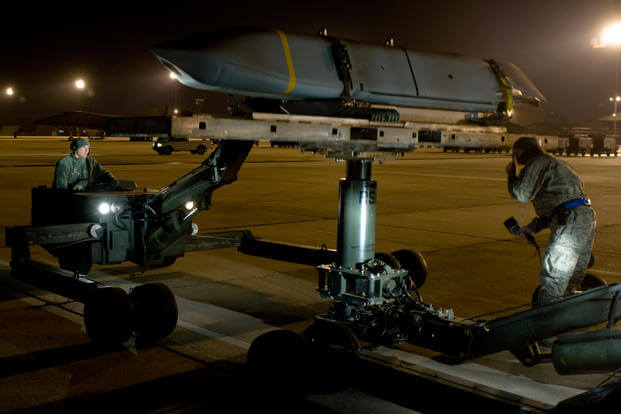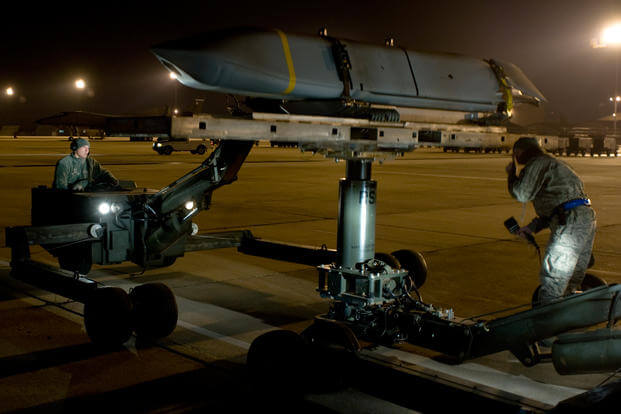
The Air Force will buy fewer Joint Direct Attack Munitions, or JDAMs; Hellfire missiles; and small-diameter bombs as it prepares to invest in state-of-the art, long-range weapons that are better-suited for operations in the Pacific, according to its fiscal 2022 budget request.
The service has requested $161 million to buy an initial production of 12 Air-launched Rapid Response Weapon, or ARRW (pronounced "Arrow"), hypersonic weapons to move it out of the research and development phase. Despite the service shifting more resources toward the ARRW program last year, the missile failed its first flight test a few weeks ago.
The Air Force also wants to increase its procurement of the Joint Air-to-Surface Standoff Missile-Extended Range, or JASSM-ER, stealth cruise missile, an advanced weapon with a range of roughly 600 miles, the budget documents state. Officials have previously stated the JASSM and its cousin, the Long-Range Anti-Ship Missile, or LRASM, can be used for stand-off precision strikes throughout the vast expanses of the Pacific region.
To fund those efforts, the service will reduce its purchases of JDAMs, the first iteration of the small-diameter bomb, and Hellfire missiles, said Maj. Gen. James D. Peccia, the Air Force deputy assistant secretary overseeing the budget at the Office of the Assistant Secretary of the Air Force for Financial Management and Comptroller.
Peccia told reporters Friday that the service has reached "healthy inventory levels" of those munitions and now will focus on the more advanced weapons.
The Air Force will ask Congress for about 1,900 JDAM munitions, according to the documents, compared to 16,800 last year. The service wants to buy only 1,176 AGM-114 Hellfire missiles this year, down from 4,517 last year. And it plans to reduce its buy of GBU-39 Small Diameter Bomb I, or SDB I, to 998 from 2,462 last year.
To bolster its inventory of conventional munitions that allow aircraft to stay outside the range of enemy air defenses, the service's funding request for JASSM-ER, which incorporates low-observable technology, has increased by $211 million "to grow production line capacity." The Air Force wants to buy 525 missiles this year, up from 400 last year, the budget states.
Over the years, the Air Force has added thousands more JDAMs, SDBs and Hellfire missiles in its effort to build up its precision-guided munition inventory.
In 2017, the service raced to buy more JDAMs and the SDB I as the Pentagon grappled with a bomb shortage driven in part by the war against the Islamic State in Iraq and Syria.
The arsenal was further strained when the joint force began sharing weapons with coalition partners engaged against the terrorist group in the Middle East, then-Lt. Gen. John Raymond, deputy chief of staff for operations at Headquarters Air Forces, said in 2016. Raymond is now chief of the U.S. Space Force.
To boost its stockpiles, the service worked with defense companies to procure precision-guided bomb packages, including tail-kits that use GPS to guide the bombs to their intended targets.
The Air Force purchased about 27,800 JDAM munitions a year between fiscal 2018 and 2020. It slowed JDAM procurements for the first time last year.

Pentagon Eyes New Bombs for War With China, Not ISIS
Despite the service shifting more resources toward the ARRW program last year, the missile failed its first flight test a few weeks ago.

